Links
Information
HELICIDAE
- Agriculture Permits: http://www.aphis.usda.gov/ppq/permits/plantpest/snails_slugs.html
- Philippe and
Julien Thomas: FranceEscargot Passion.
- Institut
für Deutsche Schneckenzucht Germany (German institute for heliciculture)
- Femorale: This site has an excellent page with links to numerous helicidae species images
- Escargot Funcia
- Raising Snails:USA: The Alternative Farming Systems Information Center, National Agricultural Library. USA All the information in one site from raising snails to the legilations on raising snails.
- Institute
Cherasco: ... The organization had its offices in the Institute
of Breeding of edible snails and
Cherasco became the point of reference for the Italian breeding activity. - Escargot.fr
: Francevotre artisan specialiste de la culture et de la ... Vente de
plats cuisin?s d'escargots. Pr?sentation de l'?levage et de l'entreprise.
- Heliciculture
- Snail farming UK: Heliciculture. Snail farming in the UK. Since making
this website, I discover
that "heliculture" is not the correct term for snail farming. ... - Snailfarming
In Australia: Raise snails for your own consumption or for a commercial
business. The time is
right to utilise a natural food resource that is literally at your feet! ...
Caution:
- It is important to clean out and treat the snails before cooking it, as snails may eat carrion and fungi. These could contain toxins and be harmful to man.
- CAUTION!
Be very careful before deciding to use the snails from your own back
yard or front yard for your next dinner party. Try to ascertain if anyone
has used snail bait for eradication of snails in you neighborhood.
Your neighbor's may be using snail poison. These snails could then migrate to your yard. REMEMBER! Some snails may only contain very small amounts of poison; so small as to not be lethal to the snail-but there may be enough residual poison that if you consumed enough of these snails IT COULD KILL YOU!
If in doubt, Please choose to be snail smart and buy your escargot from a reliable source or collect in known safe areas. These snails are a major pest and many areas use posions; So, PLEASE BEWARE!
Trivia:
- Concerning History of Snail Cultivation
- The old French used to feed their snails, picked up from nature, fine herbs, especially thyme. Because of its antiseptic properties, thyme eliminated the toxins and intensified the meat flavor.
- There are some reports of snail being farms by the Romans during their conquest of Europe. The snails were fed with flour and wine before they were slaughtered in older to enhance the meat flavor that was served to the emperors.
- A good heliciculture Links Page
- Archelix punctata
- Syn: Otala
punctata
(Müller, 1774)
called "vaqueta" in some parts of Spain, measures about 35mm across the shell.
URL

- Cantareus
aspersus
(Müller, 1774) - Syn: Helix aspersa
Ghakrux Ragel; Brown garden snail

- Considered both an agricultural pest and a delicacy.
- This is the
same species as Helix aspersa (Common
Snail, Garden snail, Brown Garden snail)
- Cepaea
hortensis
(Muller, 1774) - Syn: Helix hortensis
white-lip gardensnail; White-lipped Grove Snail; the garden snail
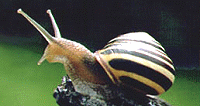
- introduced into New England in colonial times but not established ( * ) (wrong!, currently established, J.C. pers. obs.)
- Some say that snails with striped shells are not very good to eat . This plus their smaller size make hortensis and nemoralis less popular.
- See different banding patterns of this snail
-
Cepaea nemoralis
(Linnaeus, 1758)
-
Syn: Helix nemoralis
(Linnaeus, 1758)
Grovesnail, Brown-lipped
snail, wood snail,or the Spanish "vaqueta"

- Native to Central Europe, introduced into and inhabits many U.S. states, from Massachusetts to California and from Tennessee to Canada
See: Helix vermiculata for photo and information
Syn:
-
Helix vermiculata (Müller, 1774)
-
Otala vermiculata (Müller, 1774)
- Helix adanensis
- Helix (asemnis)
adanensis (escargo turc),. PDF file
Adana snail
URL
URL
?? This could be the Helix pomata snail
-
Helix aspersa (Müller,1774)
- Syn: Cantareus aspersus
Common Brown
Snail, Citrus Brown Common Snail
( the French "petit-gris" or small grey snail, escargot chagrine,"
or "La Zigrinata
URL

Crete, Turkey
Australia,
Belgium, Brasil, China, France, Korea, Spain,
United Kingdom, USA
also known as
the French "petit gris," "small grey snail," the
"escargot chagrine," or "La Zigrinata"
One source says that it's the most tender snail, rarest and tasties
- CAUTION!
Be very careful before deciding to use the snails from your own back
yard or front yard for your next dinner party. Try to ascertain if anyone
has used snail bait for eradication of snails in you neighborhood.
Your neighbor's may be using snail poison. These snails could then migrate to your yard. REMEMBER! Some snails may only contain very small amounts of poison; so small as to not be lethal to the snail-but there may be enough residual poison that if you consumed enough of these snails IT COULD KILL YOU!
If in doubt, Please choose to be snail smart and buy your escargot from a reliable source or collect in known safe areas. These snails are a major pest and many areas use posions; So, PLEASE BEWARE!
- This is a small size snail. The shell diameter can vary from 18 to 30mm and its height from 20 to 30mm. URL
- Helix aspersa maxima
the Gros-Gris; brown gardensnail
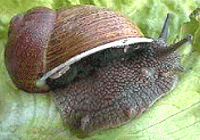
-
Helix aperta
(Born,1778)
burrowing snail; green gardensnail; green escargot snail; Crete it is called "murmúri " ; Roman grunting snail; Japan: MIDORI-ESUKARUGO

- USA: marginal agricultural pest
- Australia
Alert:
Have you seen a green snail in your garden, market garden, farm or nursery?
If so, ring Agriculture Western Australia on (08) 9368 3336.It
is olive green, unmarked and white fleshed. It could be a menace to
plants of all sorts. We must stop its spread.
-
Helix cincta
(O.F.Mueller, 1774)
L’escargot grec
URL
URL
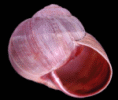 URL
URL- These snails were possibly eaten during religious ceremonies probably together with mushrooms in the past
- Helix hortensis see
- Syn: Cepaea hortensis
URL
URL

- introduced into New England in colonial times but not established ( * ) (wrong!, currently established, J.C. pers. obs.)
- Some say that snails with striped shells are not very good to eat . This plus their smaller size make hortensis and nemoralis less popular.
- See different banding patterns of this snail
Vineyard snail or Milk snail or Spanish snail
URL
URL
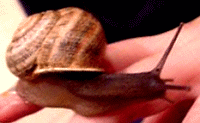 URL
URLMorocco, Spain,
Spread: North America, South America
H
sometimes called the "vineyard snail," "milk snail," or "Spanish snail"
- Originally from North Africa and Spain. Introduced to SE U.S., Bermuda, Cuba, and elswhere.
- Otala lactea or Helix lactea is popular with Italians, and is sometimes called the "vineyard snail," "milk snail," and "Spanish snail".
- USA: locally introduced into CA, TX, MS, FL, GA, Sullivans Island (SC)
- Considered better tasting than aspersa by many and just as easy to feed (vegetables and fruit diet) and breed as the helix aspersa
-
Helix lucorum
(Linnaeus, 1758)
Turk snail; sometimes "escargo turc,"
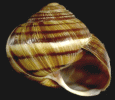 URL
URL-
Syn: Cepaea nemoralis
wood snail, the
Spanish "vaqueta,

- Native to Central Europe, introduced into and inhabits many U.S. states, from Massachusetts to California and from Tennessee to Canada
- Helix nucula
(Pfeiffer 1859)
URL
URL
-
Helix pomatia (Linnaeus, 1758)
European species)
- Helix pomatia
pomatia
(Linnaeus,1758)
Edible Snail; Bourgogne
Snail; Roman Snail
- this European snail and is preferred by many over Helix aspersa for its flavor and its larger size, as the "escargot par excellence."
- the "Roman snail," "apple snail," "luna," "La Vignaiola," the German "Weinbergschnecke," the French "escargot de Bourgogne" or "Burgundy snail," or "gros blanc,"
- USA: Helix pomatia Linnaeus, 1758: escargot: introduced at Jackson, MS
-
Helix punctata or
Otala punctata -
Syn: Archelix punctata
(Müller, 1774)
URL
URL
URL
 URL
URLcalled "vaqueta" in some parts of Spain
Mediterranean countries
(Müller 1774)
Syn:
-
Otala vermiculata
(Müller, 1774) -
Syn: Eobania vermiculata
(Müller, 1774)
the rigatella snail, noodle snail
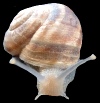 |
URL: The snail lives in gardens, hedges, and dunes, where it feeds on vegetation. The snail got its scientific name because the rings on its shell resemble vermicelli (a type of pasta). It is also sometimes called the "noodle snail." Rigatella snails commonly have about five brown rings on their cream-colored shells. Their eyes sit on stalks, or tentacles, which protrude from their heads. The snails are 17 to 21 millimeters high and 20 to 25 millimeters wide. ... |
native to the Mediterranean region, especially to Turkey and Crete.
- introduced into Louisiana and Texas
- USA: introduced into New Orleans in 1918 in Jackson Square
- also called Eobania v. or Helix v., the "vinyala," "mongeta," or "xona"--measures about 25mm. It is found in Mediterranean countries and was introduced into Louisiana and Texas.
- Iberus alonensis
(Férussac, 1801)
the Spanish "cabretes" or "xona fina,"
URL
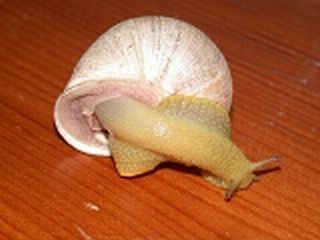 URL
URL(PROTECTED UNDER SPANISH LAW)
Overcollected as food or populations vanishing due to disappearance of favorite habitats?
- Otala
lactea:
- Syn: Helix lactea
URL
URL
 URL
URLMorocco, Spain,
Spread: North America, South America
H
sometimes called the "vineyard snail," "milk snail," or "Spanish snail"
- Originally from North Africa and Spain. Introduced to SE U.S., Bermuda, Cuba, and elswhere.
- Otala lactea or Helix lactea is popular with Italians, and is sometimes called the "vineyard snail," "milk snail," and "Spanish snail".
- USA: locally introduced into CA, TX, MS, FL, GA, Sullivans Island (SC)
- Considered better tasting than aspersa by many and just as easy to feed (vegetables and fruit diet) and breed as the helix aspersa
- Otala punctata
- Syn:Archelix punctata
"vaqueta" in some parts of Spain
URL

-
Otala vermiculata
(Müller, 1774)
See: Helix vermiculata for photo and information
Syn:
-
Helix vermiculata (Müller, 1774)
-
Otala vermiculata (Müller, 1774
-
Theba pisana
(Müller,1774)
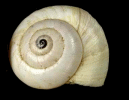 URL
URL- USA: introduced into CA but eradicated (?), pest
- This snail is a serious garden pest and it is the "white snail" that California once eradicated by using flamethrowers to burn off whole areas
URL
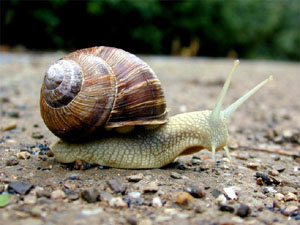 URL
URL